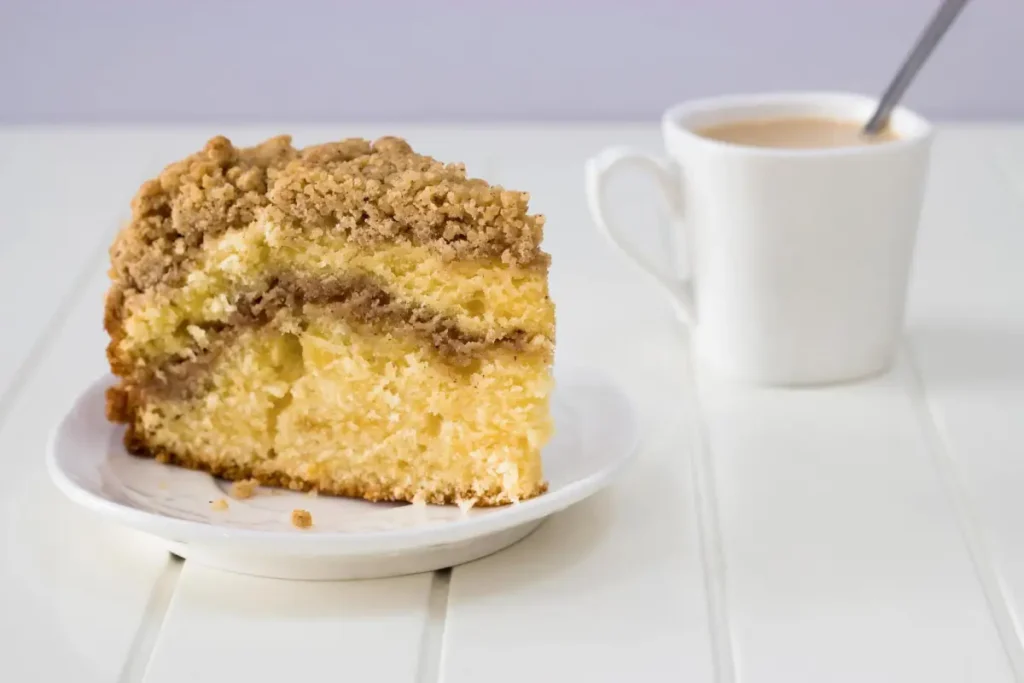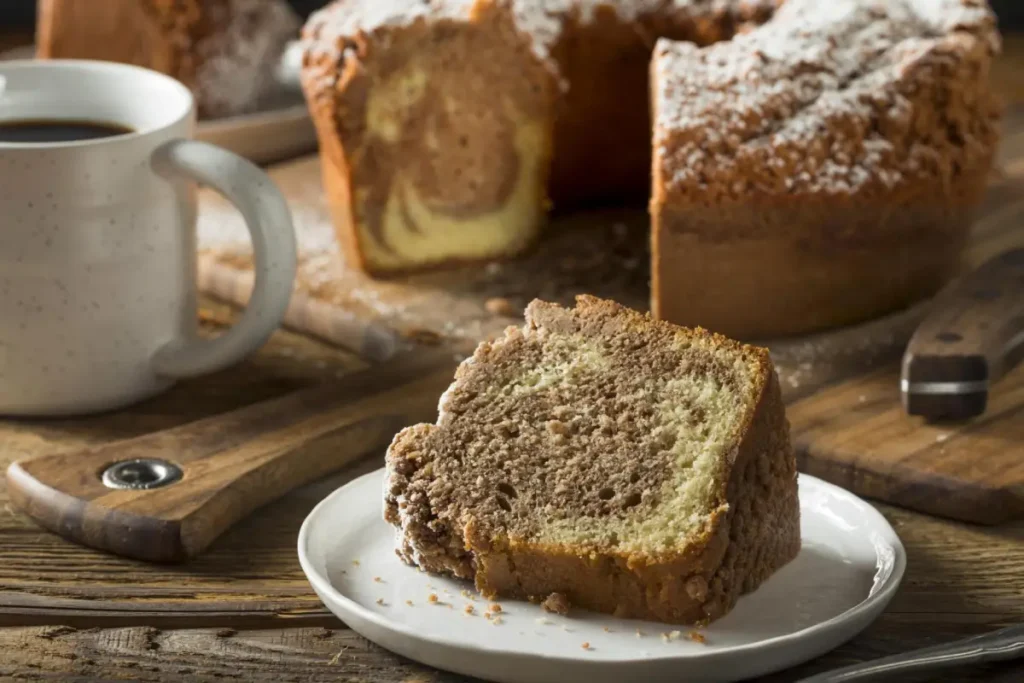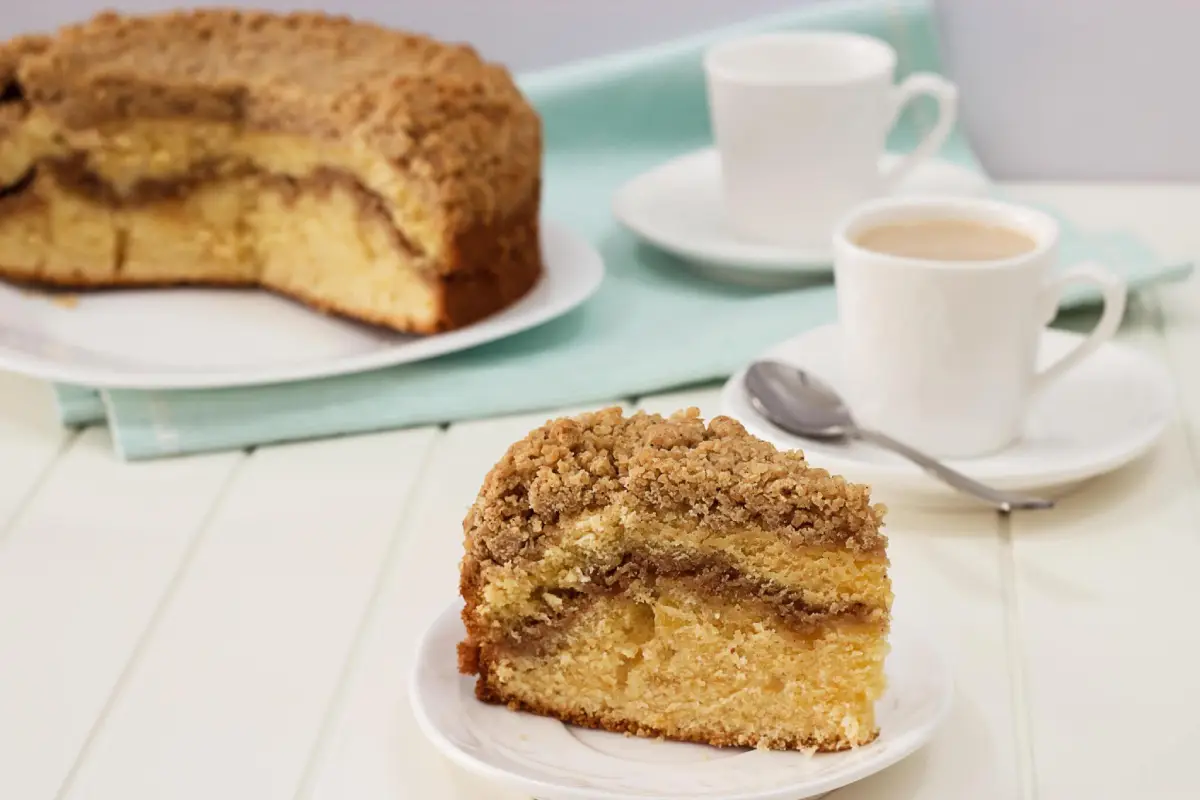In the warm, inviting world of baked delights, coffee cake stands out as a comforting beacon. This article takes a deep dive into the heart of this beloved treat, exploring whether coffee cake is traditionally meant to be dipped in coffee, its rich history, variations, and how to enjoy it at its best. From the origins that trace back to European kitchens to modern-day rituals around the globe, we unravel the threads of tradition and taste that make coffee cake a timeless favorite. So, grab a cup of your favorite brew, and let’s embark on this flavorful journey together.
A Slice of History
Long before this cake became a staple in American coffee breaks and brunch tables, it had its roots deeply planted in the soil of European tradition. The concept of pairing a sweet cake with a hot beverage dates back centuries, finding its way from European hearths to the New World with immigrants who brought their culinary traditions with them.
European Roots and Evolution
The story of coffee cake begins in the homes and cafes of Germany and Scandinavia, where kaffeeklatsch and fika, respectively, elevated the coffee break to an essential social event. These gatherings weren’t just about sipping coffee; they were about community, conversation, and, of course, enjoying a slice of cakes or pastry alongside the brew.
The German tradition of kuchen, sweet yeast breads laden with fruit and nuts, served as a precursor to the modern coffee cake. Unlike today’s cakes, which is more likely to rely on baking powder or soda for leavening, these early versions were often yeasted, creating a denser, bread-like texture.
As the concept traveled, it evolved. In America, coffee cake became synonymous with a sweet, crumbly cakes often featuring a cinnamon streusel topping, a far cry from its yeasted European cousins. Yet, the essence remained the same: a sweet treat perfect for pairing with coffee.
The term “coffee cake” might be a tad misleading, as these cakes rarely contain coffee themselves. Instead, the name reflects the cake’s role as a companion to the beverage, meant to be savored alongside a cup of joe.
From the German kuchen to the Scandinavian fika, and all the way to the American brunch table, coffee cake has woven its way into the fabric of culinary tradition, adapting to the tastes and preferences of each new home. This adaptability, this blend of the sweet with the communal joy of sharing a meal, is what makes this cake a beloved tradition across the globe.
What’s in a Coffee Cake?

Dive into the crumbly, cinnamon-scented world of coffee cake, and you’ll discover it’s as varied as the people who enjoy it. This part of our journey explores the essential ingredients that make up this beloved treat and how it morphs across different cultures, proving its versatility and universal appeal.
Key Ingredients for the Classic Taste
At its heart, the quintessential coffee cake is a simple creation that combines the rich, comforting flavors of butter, sugar, and flour with the warm, inviting spice of cinnamon. The magic, however, lies in the streusel topping—a crumbly mixture of flour, butter, and sugar, often enhanced with cinnamon or nuts. This topping not only adds texture but also a deliciously sweet contrast to the soft cake beneath.
The inclusion of sour cream or yogurt in the batter is another hallmark of a classic coffee cake. These ingredients contribute to the moistness and tender crumb of the cake, making each bite irresistibly soft and rich. Vanilla extract and eggs round out the list, lending depth of flavor and structure to the cake, respectively.
Variations Across Cultures
While the core concept of coffee cake might remain constant—being a sweet, crumbly cake enjoyed with coffee—the variations it undergoes across different regions and cultures are testament to its adaptability.
- German Influence: The German Streuselkuchen, a yeast-based cake topped with a sweet, crumbly mixture, can be considered a close relative of the American coffee cake. It reflects the tradition of enjoying a slice alongside a mid-morning or afternoon coffee.
- Scandinavian Variations: In Scandinavia, particularly Sweden, the tradition of fika—taking a break in the day to enjoy coffee and a sweet treat with friends or colleagues—is deeply ingrained. Here, coffee cake might be lighter, often cardamom-flavored, reflecting the region’s penchant for spice.
- British Tea-Time Cakes: Across the pond, the British tea-time cake shares similarities with the this cake, designed to accompany a hot drink. Though not traditionally called coffee cake, these treats often feature similar sponge cakes bases and streusel or fruit toppings.
Each variation of this cake, whether leaning towards the dense, yeasted forms of Europe or the light, baking powder-leavened cakes popular in America, shares the common thread of community and comfort. These cakes bring people together, serving as a sweet reminder of the joys of sharing a meal and conversation.
So, whether you’re enjoying a slice of this cake that’s more akin to a German kuchen or an American crumb cake, remember that each variation is a nod to the rich tapestry of culinary tradition that coffee cake represents. In its flavors, textures, and the moments it’s shared, becoming a universal symbol of hospitality and warmth.
More Than Just a Name

The connection between this cake and its namesake beverage is more than just a matter of nomenclature. This pairing is steeped in tradition, inviting us to delve into whether the cake is traditionally meant to be dipped in coffee and how modern practices have embraced or adapted this ritual.
Is Dipping Coffee Cake in Coffee a Tradition?
The idea of dipping coffee cake in coffee isn’t rooted in any strict tradition. Instead, the name “coffee cake” primarily signifies a cake that is meant to be enjoyed with coffee, rather than one that necessarily contains coffee as an ingredient or requires dipping. The concept likely stems from the European practice of serving a sweet bread alongside coffee or tea, as a complement to the beverage rather than as part of it.
However, the beauty of culinary traditions lies in their adaptability and the personal touch each individual brings to them. While not originally intended for dipping, the act of submerging a piece of moist, crumbly cake into a warm cup of coffee can enhance the flavors and textures, creating a delightful melding of taste and comfort. Whether or not to dip is a matter of personal preference, influenced by individual tastes.
Modern Practices and Preferences
Today, the enjoyment of this cake spans a wide spectrum of practices. In some circles, dipping the cake in coffee is a cherished part of the experience, adding an extra layer of flavor and texture to the ritual of coffee consumption. For others, they remain distinct, each savored for its own merits but enjoyed in tandem for the complementary flavors they bring to the table.
What remains constant is the social and culinary context that surrounds coffee cake. Whether serving as a centerpiece for a leisurely weekend brunch, a comforting treat for a mid-morning break, or a sweet conclusion to an evening meal, this cake continues to foster connections and create moments of joy.
As we navigate the nuances of this beloved tradition, it becomes clear that the essence of coffee cake is not in how it’s eaten, but in the experiences it cultivates. Whether dipped, paired, or enjoyed separately, coffee cake remains a testament to the simple pleasure of sharing good food and good company.
So, next time you slice into a warm, crumbly coffee cake, consider how you’d like to enjoy it. Whether you dip or not, the true magic of this cake lies in the moments it creates and the memories it helps to foster.
Bringing the Tradition Home
Embracing the tradition of coffee cake doesn’t require a trip to your local bakery or coffee shop. With a few simple ingredients and a bit of time, you can bring the warmth and comfort of this beloved treat into your own kitchen. Here’s a straightforward guide to baking your own coffee cake, ensuring you capture all the classic flavors and textures that make this cake a perennial favorite.
A Simple Coffee Cake Recipe to Try
Start with the basics: a tender, moist cake with a generous crumble topping. This foundation allows for endless variations, but the classic never disappoints. Here’s a basic recipe:
- For the Cake:
- 2 cups all-purpose flour
- 1 cup sugar
- 3 teaspoons baking powder
- 1/2 teaspoon salt
- 1/2 cup unsalted butter, softened
- 1 cup milk
- 2 eggs
- 1 teaspoon vanilla extract
- For the Streusel Topping:
- 1/3 cup all-purpose flour
- 1/2 cup brown sugar
- 1 teaspoon cinnamon
- 1/4 cup unsalted butter, cold and cubed
- Preheat your oven to 350°F (175°C) and grease a 9×9 inch baking pan.
- Mix the cake ingredients together until smooth, then pour into the prepared pan.
- Combine the streusel ingredients in a bowl, cutting the butter into the dry ingredients until the mixture resembles coarse crumbs.
- Sprinkle the streusel topping over the cake batter.
- Bake for 35-40 minutes, or until a toothpick inserted into the center comes out clean.
Tips for Perfect Coffee Cake Every Time
- Don’t Overmix the Batter: Overmixing can lead to a dense, tough cake. Mix just until you combine the ingredients.
- Check for Doneness Early: Oven temperatures can vary, so start checking your cake a few minutes before the recipe suggests.
- Let It Cool: Give your coffee cake time to settle and cool slightly before cutting into it. This patience pays off with perfect slices.
- Play with Add-Ins: Once you’re comfortable with the basic recipe, feel free to add nuts, fruit, or even a layer of cream cheese to the batter for variety.
Baking coffee cake at home isn’t just about the delicious end product; it’s about embracing a tradition of warmth, comfort, and hospitality. Whether you’re enjoying a slice with your morning coffee or sharing it with friends and family, homemade coffee cake offers a special kind of joy and satisfaction.
So, why not start a new tradition this weekend? Preheat your oven, gather your ingredients, and prepare to fill your home with the irresistible aroma of baking coffee cake. After all, there’s nothing quite like the pleasure of a freshly baked treat.
Crumbs of Curiosity
Even with a recipe in hand and the oven preheated, questions can arise that make you pause, spatula in hand. Here are some answers to the coffee cake conundrums that might bubble up as you whisk and mix.
Can I froze this cake?
Absolutely! Once cooled, wrap your coffee cake tightly in plastic wrap, followed by a layer of aluminum foil. You can froze it for up to three months. Thaw at room temperature or in the refrigerator overnight before serving.
Are there any gluten-free cake recipes?
Yes, there are plenty of gluten-free alternatives. Simply substitute the all-purpose flour in the cake and streusel topping with your favorite gluten-free flour blend. Check the packaging for recommendations on any additional adjustments needed for baking.
How can I make my coffee cake moist?
The secret to a moist cake lies in not overbaking it and using ingredients like sour cream or yogurt. These add moisture to the batter and contribute to a tender crumb.
Can I add fruit to my coffee cake?
Certainly! Berries, sliced apples, or peaches can be folded into the batter or layered in the middle for a burst of freshness. Just be mindful that adding too much fruit can increase baking time slightly.
What’s the best way to store coffee cake to keep it fresh?
Store your cake in an airtight container at room temperature for up to four days. If you prefer, you can also refrigerate it, which might extend its life a day or two, but be sure to let it come to room temperature before serving for the best flavor.
Armed with these FAQs, you’re now more than ready to tackle the making of coffee cake, whether it’s for a cozy morning treat, a delightful dessert, or a thoughtful gift.
The Last Crumb
As our journey through the world of coffee cake comes to a close, we’re reminded of the simple pleasures that baking and sharing such a treat can bring. This exploration has taken us from the historical roots of coffee cake across Europe to the modern-day tables around the world where it continues to be a symbol of hospitality and warmth. We’ve discovered that whether or not coffee cake is dipped in coffee is less a matter of tradition and more a personal preference, a testament to the versatility and enduring appeal of this beloved treat.
Baking this cake at home brings more than just the promise of a delicious snack; it’s an invitation to create and partake in moments of joy, connection, and comfort. With the tips and tricks we’ve shared, along with a simple yet delightful recipe, the perfect coffee cake is within reach for bakers of all levels. And as we’ve seen, the possibilities for customization and creativity are as vast as the tradition of coffee cake itself.
So, whether you’re enjoying your slice with a morning cup of joe, sharing it with friends over a leisurely brunch, or simply savoring it as a sweet end to your day, remember that each bite carries with it a rich history and a sense of shared experience.
As you set out to bake your next cake, embrace the opportunity to add your own twist, to make it a reflection of your tastes and the occasion. And most importantly, enjoy the process, from the first stir of the batter to the last crumb on the plate. Happy baking!

